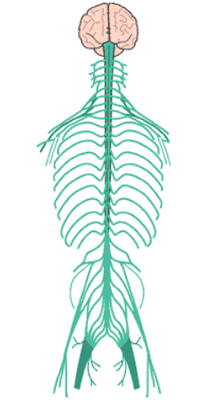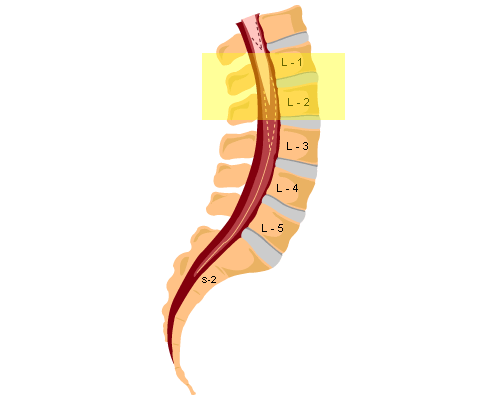The Spinal cord is the main nerve pathway from the brain to the rest of the body (Fig 1). It is contained within the vertebral canal, which is made up of 24 vertebrae forming the backbone (Fig 2).
The spinal cord gives off pairs of segmental nerves, which leave the spinal canal between each adjacent vertebra to supply much of the body (Fig 3).
It is surrounded by the dural membrane forming a sac, which contains cerebrospinal fluid.
The spinal cord ends in adults at around the 1st and 2nd lumbar vertebra but the dural sac extends lower to the sacrum (Fig 4).
Question: Why is it important to know where the spinal cord ends?

The Spinal cord is the main nerve pathway from the brain to the rest of the body (Fig 1). It is contained within the vertebral canal, which is made up of 24 vertebrae forming the backbone (Fig 2).
The spinal cord gives off pairs of segmental nerves, which leave the spinal canal between each adjacent vertebra to supply much of the body (Fig 3).
It is surrounded by the dural membrane forming a sac, which contains cerebrospinal fluid.
The spinal cord ends in adults at around the 1st and 2nd lumbar vertebra but the dural sac extends lower to the sacrum (Fig 4).
Question: Why is it important to know where the spinal cord ends?

The Spinal cord is the main nerve pathway from the brain to the rest of the body (Fig 1). It is contained within the vertebral canal, which is made up of 24 vertebrae forming the backbone (Fig 2).
The spinal cord gives off pairs of segmental nerves, which leave the spinal canal between each adjacent vertebra to supply much of the body (Fig 3).
It is surrounded by the dural membrane forming a sac, which contains cerebrospinal fluid.
The spinal cord ends in adults at around the 1st and 2nd lumbar vertebra but the dural sac extends lower to the sacrum (Fig 4).
Question: Why is it important to know where the spinal cord ends?

The Spinal cord is the main nerve pathway from the brain to the rest of the body (Fig 1). It is contained within the vertebral canal, which is made up of 24 vertebrae forming the backbone (Fig 2).
The spinal cord gives off pairs of segmental nerves, which leave the spinal canal between each adjacent vertebra to supply much of the body (Fig 3).
It is surrounded by the dural membrane forming a sac, which contains cerebrospinal fluid.
The spinal cord ends in adults at around the 1st and 2nd lumbar vertebra but the dural sac extends lower to the sacrum (Fig 4).
Question: Why is it important to know where the spinal cord ends?

The Spinal cord is the main nerve pathway from the brain to the rest of the body (Fig 1). It is contained within the vertebral canal, which is made up of 24 vertebrae forming the backbone (Fig 2).
The spinal cord gives off pairs of segmental nerves, which leave the spinal canal between each adjacent vertebra to supply much of the body (Fig 3).
It is surrounded by the dural membrane forming a sac, which contains cerebrospinal fluid.
The spinal cord ends in adults at around the 1st and 2nd lumbar vertebra but the dural sac extends lower to the sacrum (Fig 4).
Question: Why is it important to know where the spinal cord ends?
Answer: It is safest to perform a spinal below the level at which the spinal cord ends. In adults, the spinal cord ends at the level of the first lumbar vertebrae but extends lower in some people.
In order to avoid damaging the spinal cord, it is wise to insert the spinal needle no higher than the 3rd and 4th Lumbar interspace (L3/4).
